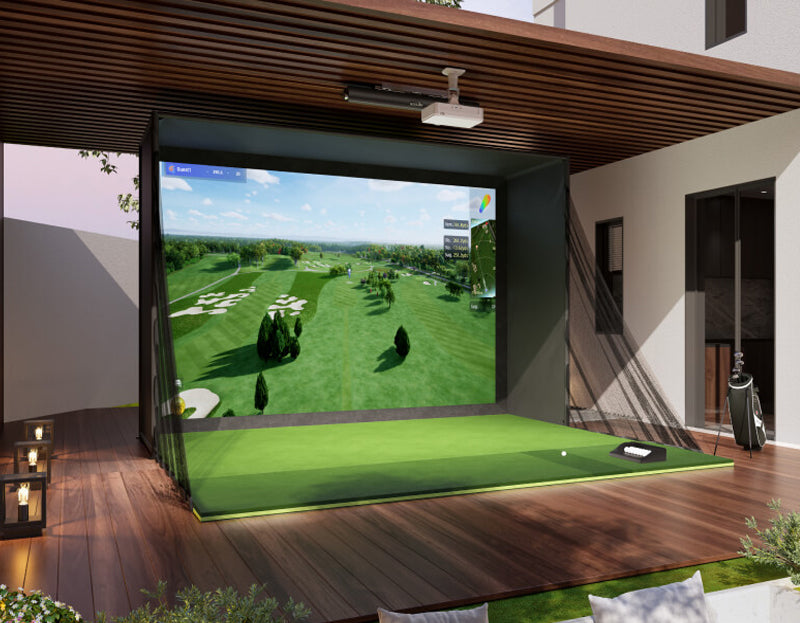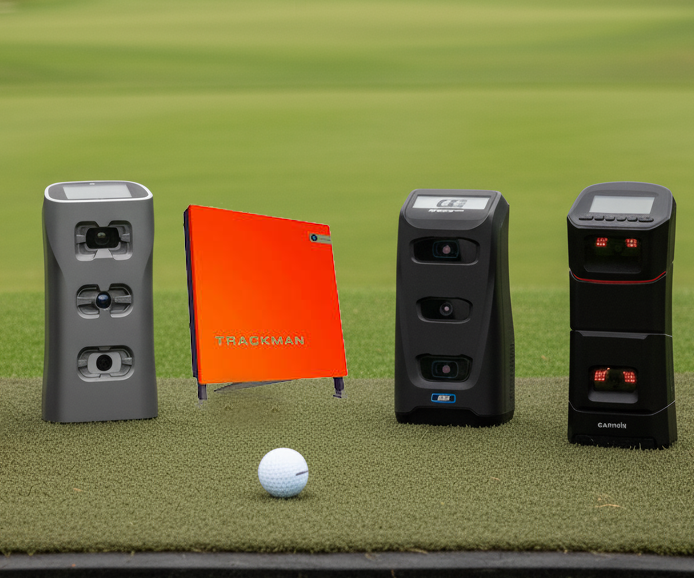Bringing the golf course into your home has never been easier, and home golf simulators are booming for practice, entertainment, and year-round improvement. The first question most golfers ask is: how much does a home golf simulator cost? That concern — the home golf simulator price — drives every buying decision. There’s no single answer: your total spend depends on the components you choose (launch monitor, impact screen, mat, projector), the complexity of your setup, and the size and ceiling height of your space. This guide breaks down realistic price ranges and shows how to get the best value.
Typical Home Golf Simulator Price Ranges
When considering golf simulator cost, it’s important to understand the features and components included at different price levels. Golf simulator pricing varies widely based on launch monitors, hitting mats, impact screens, projectors, and software. Here’s a clear breakdown of how much are golf simulators at each level:
When considering golf simulator cost, it’s important to understand the features and components included at different price levels. Golf simulator pricing varies widely based on launch monitors, hitting mats, impact screens, projectors, and software. Here’s a clear breakdown of how much are golf simulators at each level:
| Price Level | Approx. Cost | Representative Brands |
|---|---|---|
| Entry-Level | <$1,000 | Phigolf 2 OptiShot 2 |
| Mid-Range | $5,000–$10,000 | GOLFJOY SkyTrak Garmin Foresight |
| Premium / Commercial | $17,000+ | TrackMan Uneekor |
By contrast, most home golf simulators under $1,000 typically include only basic software and a swing stick or sensor — some may add a simple hitting mat or net, but they rarely provide a true on-screen experience.
For players who care about realistic ball flight, shot data, and overall immersion, it’s worth investing in a mid-range or higher-tier setup, where you’ll get a quality launch monitor, impact screen, and enclosure that make practice feel like real golf.Compared to other mid- and high-end options, GOLFJOY offers excellent value for home golfers, delivering accurate data and immersive gameplay at a competitive price.
Price information is based on publicly available sources and may vary depending on configuration and dealer.
Key Components That Drive Cost
When assessing the cost of a golf simulator, it’s not just the launch monitor that determines price — components like the impact screen/enclosure, hitting mat or turf, and display or projector all push the home golf simulator price up significantly. Below is a comparison of what major brands include in their standard or bundle packages for these core components:
| Brand | Avg Launch Monitor Price | Impact Screen & Enclosure | Hitting Mat / Turf | Projector |
|---|---|---|---|---|
| TrackMan | $13,000-$20,000+ | ✅ Included in many bundles (screen + enclosure) | ✅ Premium mat included | ✅ HD projector |
| Foresight Sports | $3,000-$20,000 | ✅ Enclosure & Hitting screen | ✅ Mat &Turf | ✅ Projector |
| SkyTrak+ | $1,000-$2,000 | ✅ Screen & enclosure | ✅ Hitting Mat | ✅ Projector |
| Uneekor | $3,000-$8,000 | ✅ Screen & enclosure | ✅ Hitting Mat | ✅ Projector |
| GOLFJOY | $2,000–$3,000 | ✅ Included as standard | ✅ Mat included | ✅ Projector & one-year software use |
Information is based on publicly available sources and may vary depending on configuration and dealer.
Hidden costs to watch out for:
Even for bundles that appear all-inclusive, some software subscriptions, annual licensing, or course-library fees may not be included. Also, installation, shipping, calibration, and room modifications (ceiling height, electrical, mounting hardware) can add to the total. These are often overlooked when comparing advertised prices.
DIY vs Pre-Built vs Commercial Simulators
When deciding how much a simulator costs, the first step is choosing between a DIY build, a pre-built package, or a commercial indoor golf simulator.
A DIY setup can keep your in-home golf simulator cost low — often $1,000–$3,000 — but it requires solid tech skills, sourcing parts, and troubleshooting software.
Pre-built systems strike a balance between price and convenience: for $5,000–$10,000, you get calibrated launch monitors, impact screens, and hitting mats with professional support.
Brands like GOLFJOY make this option even easier — when you purchase a home golf simulator from GOLFJOY, you’ll receive clear assembly videos and can get remote assistance anytime, ensuring you enjoy your simulator as soon as possible.
At the top end, commercial indoor golf simulator prices can exceed $20,000, delivering high-definition graphics, advanced swing analytics, and premium enclosures designed for teaching studios or entertainment venues.
Your choice depends on budget, technical comfort, and the level of realism you expect.
Space Requirements & Overhead Considerations
Before investing in a simulator, it’s important to plan the room itself — space can influence both comfort and cost. A good rule of thumb for how much space you need for a golf simulator is at least 10 ft (3 m) wide, 10 ft deep, and 9–10 ft high so you can swing freely without feeling cramped.
Ceiling height matters even more if you choose an overhead golf simulator, since its launch monitor mounts above the hitting area and needs extra clearance for sensors and wiring. Portable setups, by contrast, often work in smaller spaces and can be stored away when not in use.
Factoring in room size early helps you avoid expensive adjustments later and ensures you’ll enjoy smooth ball flight tracking, safe impact screen placement, and a comfortable stance line.
Hidden Costs & Ongoing Expenses
When planning your simulator budget, don’t forget the expenses that come after the initial purchase. One of the most common is golf simulator software cost — many systems require annual or monthly subscription fees to access premium courses, multiplayer modes, or advanced analytics.
Over time, you may also need to replace hitting mats, impact screens, or worn sensors, and occasional maintenance or hardware upgrades can add to the total. Factoring in these ongoing costs from the start helps you choose a setup that fits your budget long-term, not just at checkout.
Best Value Options by Budget Level
Finding an affordable golf simulator depends on how much realism and durability you need. At the entry level (under $1,000), you’ll mostly see basic swing trainers or app-based kits — great for casual practice but limited in accuracy and visuals. Stepping up to the best home golf simulator under $5000 brings better launch monitors, impact screens, and sturdier hitting mats, offering a far more realistic playing experience.
In the $5,000–$10,000 range, you’ll find balanced solutions that blend performance and value — this is where the GOLFJOY home simulator stands out. It delivers professional-grade ball data, a bright impact screen, and one year of software access, all at a mid-range price that makes enjoying a true indoor round more attainable. For those chasing tour-level immersion, premium setups above $20,000 offer the ultimate full-swing experience, but for most golfers, a solid mid-range system provides the best return on investment.
Conclusion
When considering how much does a home golf simulator cost, remember that prices vary with launch monitor quality, screen size, hitting mat durability, and extra features like software and enclosures. Entry-level kits can be found for under $1,000, but they rarely provide a truly enjoyable playing experience. Mid-range systems, such as the GOLFJOY home simulator, typically run around $6,000–$8,000, while premium commercial setups can exceed $20,000.
If you’re looking for a realistic setup without overspending, GOLFJOY delivers excellent performance and a competitive home golf simulator price. Explore our range of simulators to find the package that fits your space, budget, and goals — and start enjoying accurate practice and immersive play from the comfort of home.
FAQ
What is included in a basic home golf simulator setup?
A basic home golf simulator usually includes a launch monitor, an impact screen or hitting net, and a hitting mat. Entry-level kits under $1,000 often focus on software and a swing stick, while mid-range systems add higher-quality sensors, durable mats, and larger screens for a more realistic experience.
How much space do I need for a home golf simulator?
Plan for at least 10 ft (3 m) wide, 10 ft deep, and 9–10 ft high so you can swing safely and comfortably. If you choose an overhead golf simulator, allow extra ceiling height for the mounted launch monitor and wiring.
Can I build a golf simulator under $2,000?
Yes, but it will likely be very basic — often just simulator software, a swing stick, and a small mat or net. These can help you practice indoors but won’t match the realism of a full setup. For a better experience, consider a mid-range option such as the GOLFJOY home simulator.
How does launch monitor type affect cost?
Launch monitors vary widely in price and accuracy. Budget-friendly models like the Garmin Approach R10 or SkyTrak+ work well for casual golfers, while premium systems such as TrackMan, Foresight Sports, or Uneekor deliver tour-level precision at a higher cost. The GOLFJOY launch monitor offers a strong balance of performance and value in the mid-range segment.
Are there ongoing costs like software subscriptions?
Many simulators charge annual or monthly fees to access advanced courses, multiplayer play, or analytics tools. Always check the golf simulator software cost before you buy. A major advantage of the GOLFJOY home simulator is that it includes one year of software access with no hidden subscription fees.








コメントを書く
全てのコメントは、掲載前にモデレートされます
このサイトはhCaptchaによって保護されており、hCaptchaプライバシーポリシーおよび利用規約が適用されます。